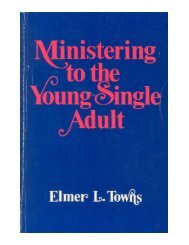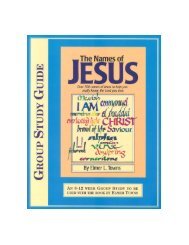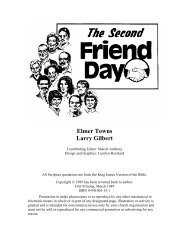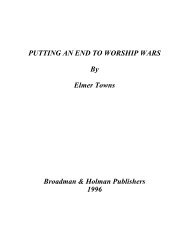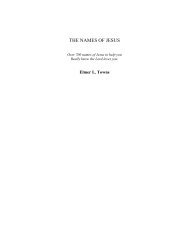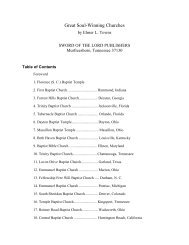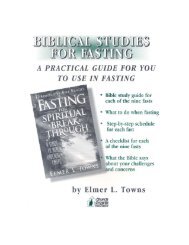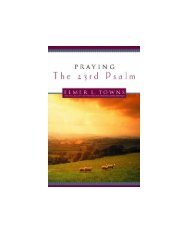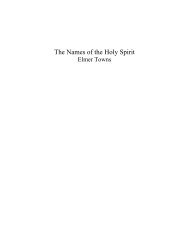A Journey Through The Old Testament - Elmer Towns
A Journey Through The Old Testament - Elmer Towns
A Journey Through The Old Testament - Elmer Towns
Create successful ePaper yourself
Turn your PDF publications into a flip-book with our unique Google optimized e-Paper software.
<strong>The</strong> tabernacle was erected according to the plan and pattern given by God. “So Moses<br />
finished the work” (40:33). Perhaps it was then that Moses prayed a prayer which has since then<br />
become a source of inspiration to all who seek to do a work for God. “Lord, You have been our<br />
dwelling place in all generations.... Let Your work appear to your servants, and Your glory to<br />
their children. And let the beauty of the Lord our God be upon us, and establish the work of our<br />
hands for us; yes, establish the work of our hands” (Ps. 90:1, 16-17).<br />
It may well have been in answer to the “prayer of Moses, the man of God” that God<br />
moved into His new dwelling place in the wilderness. “<strong>The</strong>n the cloud covered the tabernacle of<br />
meeting, and the glory of the Lord filled the tabernacle” (Ex. 40:34). And there from the<br />
tabernacle, God began to speak to Moses and the Children of Israel. <strong>The</strong> various statements of<br />
God made during the next month have been preserved in the third Book of Moses called<br />
Leviticus.<br />
THE LEVITICAL SYSTEM OF WORSHIP<br />
(Lev.)<br />
Ironically, the one book of the Bible specifically said to contain more of the actual<br />
spoken words of God than any other is the book least likely to be read by a Christian today.<br />
Because so much of the Book of Leviticus is attributed to the direct statements from God, Jewish<br />
rabbis coined the phrase, “Let the pure read the pure.” By this they meant children who were<br />
thought to be pure should be taught to read by reading the Book of Leviticus which came to be<br />
known as the, pure Word of God. This means the first book to be read by Jesus as He grew up in<br />
Nazareth is probably the last book to be read by Christians today.<br />
<strong>The</strong>re are several highlights in the Book of Leviticus which are of special significance to<br />
Christians today. <strong>The</strong> book begins with instructions concerning the five major offerings in the<br />
levitical system of worship. Most commentators agree the first of these, the whole burnt offering,<br />
is the model on which the Apostle Paul’s challenge to the Romans to be “a living sacrifice” (cf.<br />
Rom. 12:1). This sacrifice involved burning the complete animal as an offering to God and came<br />
to represent the highest expression of commitment to God in the Law. <strong>The</strong>re is even greater<br />
agreement that Christ offered Himself as each of these five sacrifices in His death on Calvary.<br />
<strong>The</strong> first seven chapters of the Book of Leviticus became the manual of sacrifice for<br />
Israel and her priests. <strong>The</strong> first part of this manual was addressed to the people and stressed their<br />
responsibility in the area of sacrifice (Lev. 1:1-6:7). <strong>The</strong> second part of this section of the book<br />
was addressed to the priests and outlined their privilege regarding the sacrifices (6:8-7:38). Only<br />
one of the five sacrifices was offered without blood, the meal offering.



